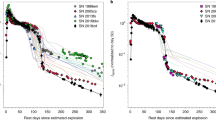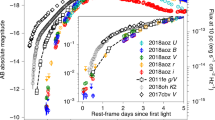Abstract
The final steps of the evolution of massive stars leading to a supernova explosion, in particular the mass-loss mechanism, is an important open problem in astrophysics. Stripped-envelope supernovae (SESNe) are explosions of massive stars where a large amount of the outer envelope has been stripped away before the explosion: types IIb, Ib and Ic in order of increasing degree of envelope stripping1,2,3. In this work, an analysis of late-time nebular spectra of SESNe is presented. The results show that the progenitors of SNe IIb and Ib are indistinguishable except for the residual amount of the H-rich envelope. The progenitors of SNe Ic are distinctly different in the nature of the carbon–oxygen (C+O) core, which is interpreted to be more massive than in SNe IIb and Ib. These findings strongly suggest that different mechanisms are responsible for the removal of the outer H-rich envelope and the deeper He-rich layer.
This is a preview of subscription content, access via your institution
Access options
Access Nature and 54 other Nature Portfolio journals
Get Nature+, our best-value online-access subscription
$29.99 / 30 days
cancel any time
Subscribe to this journal
Receive 12 digital issues and online access to articles
$119.00 per year
only $9.92 per issue
Buy this article
- Purchase on Springer Link
- Instant access to full article PDF
Prices may be subject to local taxes which are calculated during checkout



Similar content being viewed by others
Data availability
Most of the light curves and spectra are available from WiseRep, The Open Supernova Catalogue and Supernova Database of Berkeley. The data that support the plots within this paper and other findings of this study are available from the corresponding authors upon reasonable request.
References
Filippenko, A. V. Optical spectra of supernovae. Annu. Rev. Astron. Astrophys. 35, 309–355 (1997).
Gal-Yam, A. in Handbook of Supernovae (eds Alsabti, A. W. & Murdin, P.) 195 (Springer International Publishing AG, Cham, Switzerland, 2017).
Nomoto, K. I., Iwamoto, K. & Suzuki, T. The evolution and explosion of massive binary stars and Type Ib-Ic-IIb-IIL supernovae. Phys. Rep. 256, 173–191 (1995).
Heger, A., Fryer, C. L., Woosley, S. E., Langer, N. & Hartmann, D. H. How massive single stars end their life. Astrophys. J. 591, 288–300 (2003).
Ouchi, R. & Maeda, K. Radii and mass-loss rates of Type IIb supernova progenitors. Astrophys. J. 840, 90 (2017).
Yoon, S.-C. Towards a better understanding of the evolution of Wolf–Rayet stars and Type Ib/Ic supernova progenitors. Mon. Not. R. Astron. Soc. 470, 3970–3980 (2017).
Chevalier, R. A. & Soderberg, A. M. Type IIb supernovae with compact and extended progenitors. Astrophys. J. Lett. 711, L40–L43 (2010).
Iwamoto, K. et al. A hypernova model for the supernova associated with the γ ray burst of 25 April 1998. Nature 395, 672–674 (1998).
Groh, J. H., Georgy, C. & Ekström, S. Progenitors of supernova Ibc: a single Wolf-Rayet star as the possible progenitor of the SN Ib iPTF13bvn. Astron. Astrophys. 558, L1 (2013).
Smith, N. Mass loss: its effect on the evolution and fate of high-mass stars. Annu. Rev. Astron. Astrophys. 52, 487–528 (2014).
Yoon, S.-C. Evolutionary models for Type Ib/c supernova progenitors. Publ. Astron. Soc. Aust. 32, e015 (2015).
Eldridge, J. J., Fraser, M., Smartt, S. J., Maund, J. R. & Crockett, R. M. The death of massive stars—II. Observational constraints on the progenitors of Type Ibc supernovae. Mon. Not. R. Astron. Soc. 436, 774–795 (2013).
Liu, Y.-Q., Modjaz, M., Bianco, F. B. & Graur, O. Analyzing the largest spectroscopic data set of stripped supernovae to improve their identifications and constrain their progenitors. Astrophys. J. 827, 90 (2016).
Lyman, J. D. et al. Bolometric light curves and explosion parameters of 38 stripped-envelope core-collapse supernovae. Mon. Not. R. Astron. Soc. 457, 328–350 (2016).
Taddia, F. et al. The Carnegie Supernova Project I. Analysis of stripped-envelope supernova light curves. Astron. Astrophys. 609, A136 (2018).
Anderson, J. P., Habergham, S. M., James, P. A. & Hamuy, M. Progenitor mass constraints for core-collapse supernovae from correlations with host galaxy star formation. Mon. Not. R. Astron. Soc. 424, 1372–1391 (2012).
Kuncarayakti, H. et al. Constraints on core-collapse supernova progenitors from explosion site integral field spectroscopy. Astron. Astrophys. 613, A35 (2018).
Fremling, C. et al. Oxygen and helium in stripped envelope supernovae. Astron. Astrophys. 618, A37 (2018).
Jerkstrand, A. et al. The progenitor mass of the Type IIP supernova SN 2004et from late-time spectral modeling. Astron. Astrophys. 546, A28 (2012).
Kuncarayakti, H. et al. Nebular phase observations of the Type-Ib supernova iPTF13bvn favour a binary progenitor. Astron. Astrophys. 579, A95 (2015).
Maeda, K. et al. SN 2006aj associated with XRF 060218 at late phases: nucleosynthesis signature of a neutron star-driven explosion. Astrophys. J. 658, L5–L8 (2007).
Jerkstrand, A. et al. Late-time spectral line formation in Type IIb supernovae, with application to SN 1993J, SN 2008ax, and SN 2011dh. Astron. Astrophys. 573, A12 (2015).
Fang, Q. & Maeda, K. The origin of the Hα-like structure in nebular spectra of Type IIb supernovae. Astrophys. J. 864, 47 (2018).
Dessart, L., Hillier, D. J., Li, C. & Woosley, S. On the nature of supernovae Ib and Ic. Mon. Not. R. Astron. Soc. 424, 2139–2159 (2012).
Yoon, S.-C., Chun, W., Tolstov, A., Blinnikov, S., & Dessart, L. Type Ib/Ic supernovae: effect of nickel mixing on the early-time color evolution and implications for the progenitors. Preprint at https://arxiv.org/abs/1810.03108 (2018).
Smartt, S. J. Progenitors of core-collapse supernovae. Annu. Rev. Astron. Astrophys. 47, 63–106 (2009).
Vanbeveren, D., De Loore, C. & Van Rensbergen, W. Massive stars. Astron. Astrophys. Rev. 9, 63–152 (1998).
Yoon, S.-C., Dessart, L. & Clocchiatti, A. Type Ib and IIb supernova progenitors in interacting binary systems. Astrophys. J. 840, 10 (2017).
Pastorello, A. et al. A giant outburst two years before the core-collapse of a massive star. Nature 447, 829–832 (2007).
Smith, N., Mauerhan, J. C. & Prieto, J. L. SN 2009ip and SN 2010mc: core-collapse Type IIn supernovae arising from blue supergiants. Mon. Not. R. Astron. Soc. 438, 1191–1207 (2014).
Yaron., O. & Gal-Yam, A. WISeREP—an interactive supernova data repository. Publ. Astron. Soc. Pac. 124, 668–681 (2012).
Guillochon, J., Parrent, J., Kelley, L. Z. & Margutti, R. An open catalog for supernova data. Astrophys. J. 835, 64 (2017).
Shivvers, I. et al. The Berkeley sample of stripped-envelope supernovae. Mon. Not. R. Astron. Soc. 482, 1545–1556 (2019).
Tauris, T. M., Langer, N. & Podsiadlowski, P. Ultra-stripped supernovae: progenitors and fate. Mon. Not. R. Astron. Soc. 451, 2123–2144 (2015).
Jerkstrand, A. et al. Long-duration superluminous supernovae at late times. Astrophys. J. 835, 13 (2017).
Arnett, W. D. Type I supernovae. I. Analytic solutions for the early part of the light curve. Astrophys. J. 253, 785–797 (1982).
Valenti, S. et al. The broad-lined Type Ic supernova 2003jd. Mon. Not. R. Astron. Soc. 383, 1485–1500 (2008).
Makarov, D., Prugniel, P., Terekhova, N., Courtois, H. & Vauglin, I. HyperLEDA. III. The catalogue of extragalactic distances. Astron. Astrophys. 570, A13 (2014).
Turatto, M., Benetti, S. & Cappellaro, E. in From Twilight to Highlight: The Physics of Supernovae (eds Hillebrandt, W. & Leibundgut, B.) 200–209 (Springer-Verlag, Berlin Heidelberg, 2003).
Drout, M. R. et al. The first systematic study of Type Ibc supernova multi-band light curves. Astrophys. J. 741, 97 (2011).
Jerkstrand, A. in Handbook of Supernovae (eds Alsabti, A. W. & Murdin, P.) 795 (Springer International Publishing AG, Cham, Switzerland, 2017).
Elmhamdi, A. et al. SN Ib 1990I: clumping and dust in the ejecta? Astron. Astrophys. 426, 963–977 (2004).
Fransson, C. & Chevalier, R. A. Late emission from supernovae—a window on stellar nucleosynthesis. Astrophys. J. 343, 323–342 (1989).
Jerkstrand, A. et al. The nebular spectra of SN 2012aw and constraints on stellar nucleosynthesis from oxygen emission lines. Mon. Not. R. Astron. Soc. 439, 3694–3703 (2014).
Anderson, J. P. et al. The lowest-metallicity type II supernova from the highest-mass red supergiant progenitor. Nat. Astron. 2, 574–579 (2018).
O’Connor, E. & Ott, C. D. Black hole formation in failing core-collapse supernovae. Astrophys. J. 730, 70 (2011).
Suwa, Y., Tominaga, N. & Maeda, K. Importance of 56Ni production on diagnosing explosion mechanism of core-collapse supernova. Mon. Not. R. Astron. Soc. 483, 3607–3617 (2019).
Ennis, J. A. et al. Spitzer IRAC images and sample spectra of Cassiopeia A’s explosion. Astrophys. J. 652, 376–386 (2006).
Acknowledgements
Q.F. acknowledges support by MEXT scholarship awarded by Ministry of Education, Culture, Sports, Science and Technology, Japan. K.M. acknowledges support by JSPS KAKENHI Grant (18H04585, 18H05223, 17H02864). A.G.-Y. is supported by the EU via ERC grant number 725161, the ISF, the BSF Transformative program and by a Kimmel award. We thank A. Morales-Garoffolo for kindly providing the nebular spectra of SN 2013df. We thank WiseRep, the Open Supernova Catalog and the Berkeley Supernova Database for access to supernova data.
Author information
Authors and Affiliations
Contributions
Q.F. led the nebular spectral analysis and the manuscript preparatoin. K.M. contributed to the initiation of the project together with Q.F. K.M. and A.G.-Y. organized the efforts for interpretation of the results and assisted in manuscript preparation. H.K. contributed to the spectral analysis and interpretations. F.S. assisted in the spectral analysis. All authors contributed to discussion.
Corresponding authors
Ethics declarations
Competing interests
The authors declare no competing interests.
Additional information
Journal peer review information: Nature Astronomy thanks Mattias Ergon and the other anonymous reviewer(s) for their contribution to the peer review of this work.
Publisher’s note: Springer Nature remains neutral with regard to jurisdictional claims in published maps and institutional affiliations.
Supplementary information
Supplementary Information
Supplementary Figures 1–4, Supplementary Tables 1–6, Supplementary references.
Rights and permissions
About this article
Cite this article
Fang, Q., Maeda, K., Kuncarayakti, H. et al. A hybrid envelope-stripping mechanism for massive stars from supernova nebular spectroscopy. Nat Astron 3, 434–439 (2019). https://doi.org/10.1038/s41550-019-0710-6
Received:
Accepted:
Published:
Issue Date:
DOI: https://doi.org/10.1038/s41550-019-0710-6
This article is cited by
-
An aspherical distribution for the explosive burning ash of core-collapse supernovae
Nature Astronomy (2023)
-
A superluminous supernova lightened by collisions with pulsational pair-instability shells
Nature Astronomy (2023)



